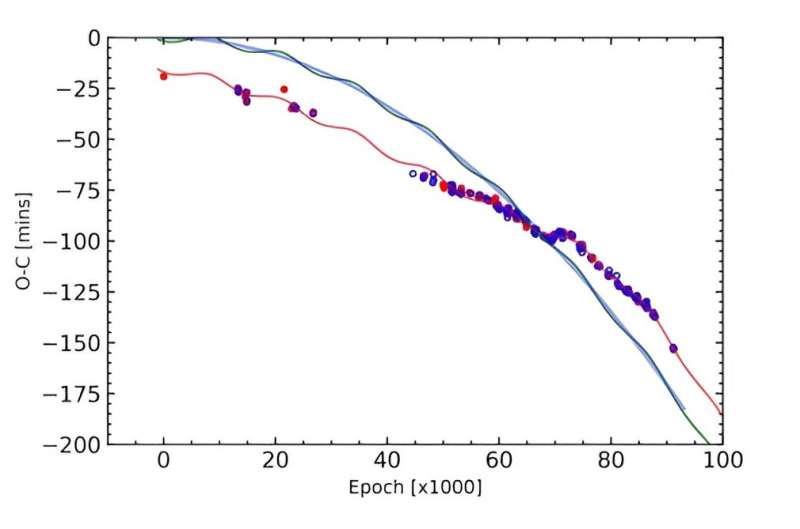July 24, 2024 report
This article has been reviewed according to Science X's editorial process and policies. Editors have highlighted the following attributes while ensuring the content's credibility:
fact-checked
preprint
trusted source
proofread
Two additional components of the CC Com system found

Using the TÜBİTAK National Observatory (TUG) and NASA's Transiting Exoplanet Survey Satellite (TESS), astronomers have investigated a short-period contact binary known as CC Com. As a result, they detected two additional objects in this system. The finding was reported in a paper published July 16 on the pre-print server arXiv.
Contact binaries are systems in which the two stars are so close to each other that they share a common envelope of gas. Studying such systems can help us better understand how stars evolve when they interact closely with each other and can advance our knowledge regarding the formation mechanisms of merging phenomena.
CC Com is a short-period contact binary of spectral type K4/5 V located some 225 light years away. Previous observations have found that the primary star has a radius of about 0.72 solar radii and its mass is approximately 0.75 solar masses. The secondary star has a radius of 0.55 solar radii, while its mass is estimated to be 0.41 solar masses. The orbital period of the binary is approximately 0.22 days.
Recently, a team of astronomers led by Dolunay Koçak of the University of Cambridge, UK, decided to take a closer look at CC Com. They used TUG and TESS to conduct a comprehensive study of this system, finding that it contains more objects than previously thought.
"In this study, the nature of CC Com has been analyzed in detail. In addition to the new observations obtained with the TUG telescopes, all available light curves of the system observed by TESS were collected for use in the light curve analysis," the scientists wrote.
The observations revealed the presence of two additional objects in the system, which received designation CC Com B and CC Com C. The previously known pair of stars was therefore designated CC Com A.
According to the study, the mass of CC Com B is estimated to be 0.074 solar masses, while that of CC Com C is most likely at a level of 0.18 solar masses. The orbital periods of CC Com B and CC Com C were measured to be about 7.9 and 98 years, respectively.
The collected data also allowed the team to refine the parameters of CC Com A binary and it turned out that its components are smaller and less massive than previously thought. It turned out that the radii of the primary and secondary star are 0.69 and 0.51 solar radii, respectively, while their masses were found to be 0.71 and 0.37 solar masses, respectively.
Summing up the results, the researchers propose further studies of CC Com, which could improve our understanding regarding the nature of interacting binary stars and merger processes.
More information: Dolunay Koçak, The multiple nature of CC Com: one of the ultra-short orbital period late-type contact binary systems, arXiv (2024). DOI: 10.48550/arxiv.2407.12085
Journal information: arXiv
© 2024 Science X Network





















